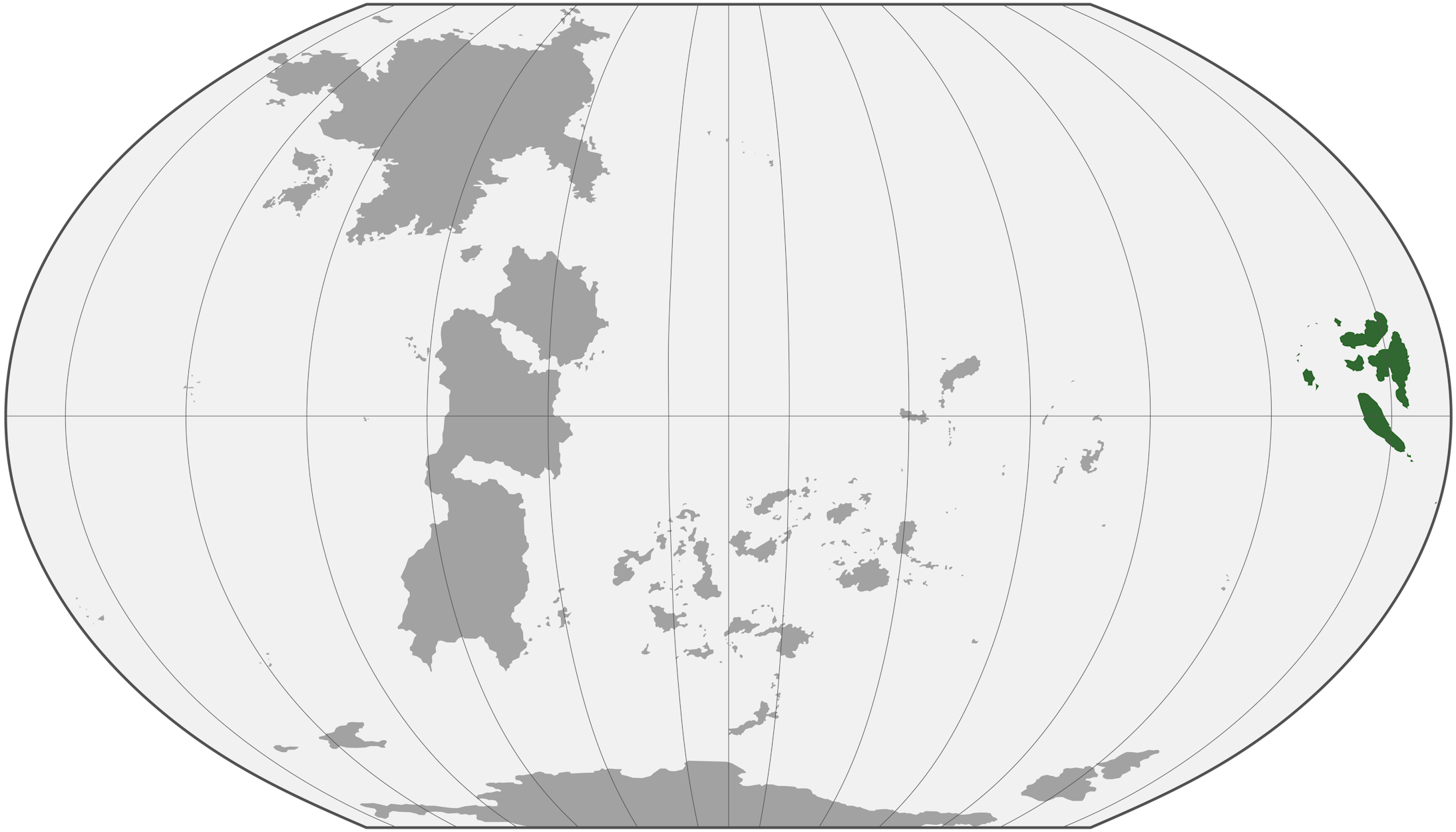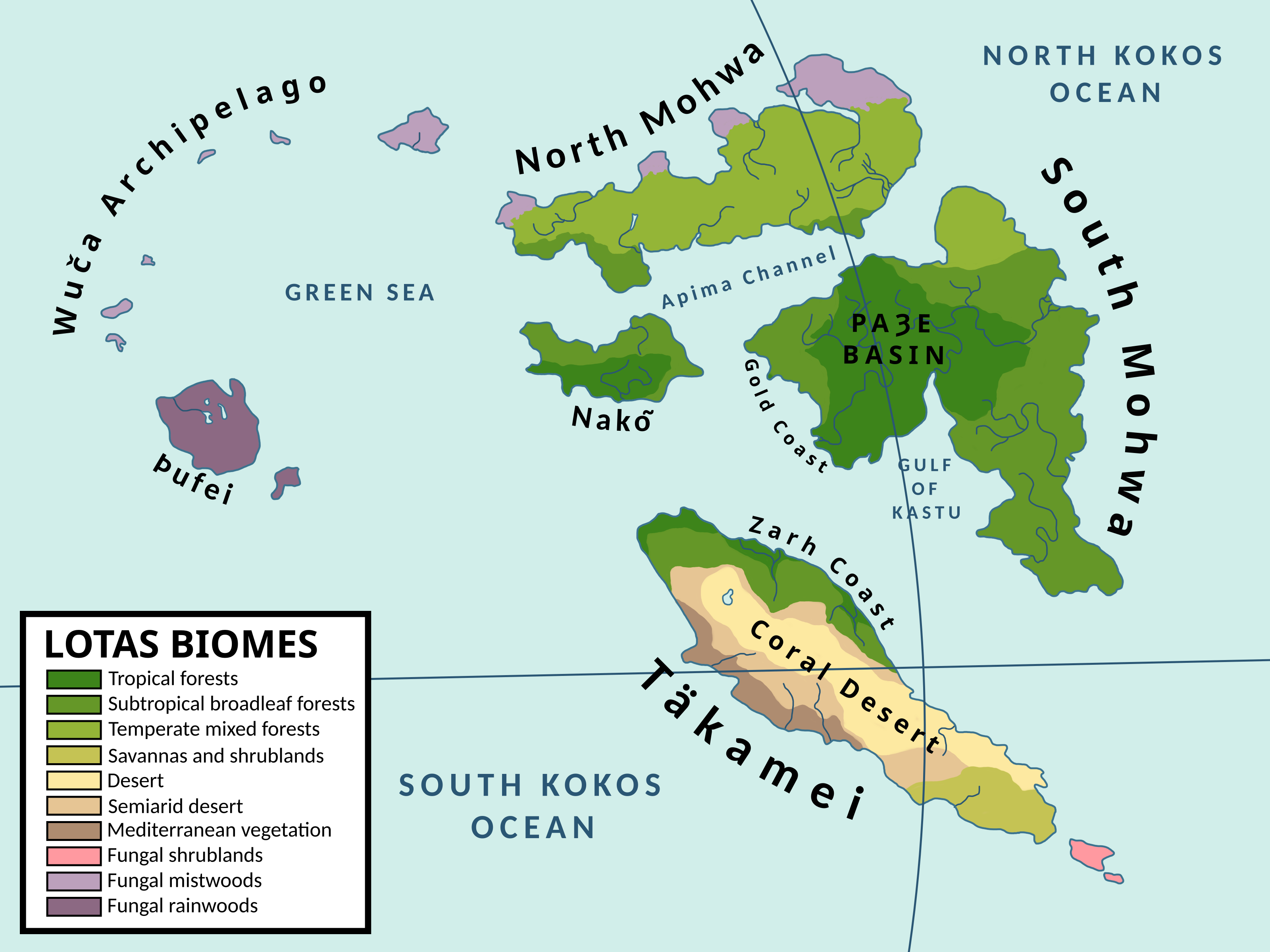Lotaš is an isolated group of islands situated in the vast expanse of the Kokos Ocean. During this timeline, the islands remain undiscovered by the outside world, holding a role analogous to that of the New World prior to its exploration. The human inhabitants of Lotaš are at a mesolithic stage of technological development, with their societies characterized by simple tools and a deep connection to their natural environment.
The islands of Lotaš are renowned for their unique and exotic ecosystems, featuring biomes and species found nowhere else on the planet. These isolated environments have given rise to a rich tapestry of biodiversity, making Lotaš an extraordinary and mysterious region, shrouded in both ecological and cultural intrigue.
Climate
The climate of Lotaš is highly varied, reflecting the diverse landscapes and ecosystems across the islands. In the northernmost part of Lotaš, temperate forests dominate the landscape, characterized by moderate temperatures and seasonal variations. These forests are home to a rich variety of plant and animal life, thriving in the cooler, stable climate.
Moving towards the central part of Lotaš, the climate transitions into subtropical moist forests. This region experiences warmer temperatures and higher humidity, supporting dense, lush vegetation. The subtropical forests are teeming with diverse flora and fauna, sustained by frequent rainfall and a warm climate.
The western islands of Lotaš are known for their distinct, colder climates, which support unique fungal vegetation. These "Mushroom Islands" are characterized by damp, misty conditions that allow giant fungi to flourish, creating an otherworldly landscape dominated by towering mushrooms and a cool, humid environment.
In contrast, the southern part of Lotaš is a semiarid desert, marked by dry, hot conditions and a landscape scattered with dried-out coral remnants. This harsh environment supports sparse, drought-resistant vegetation and presents a stark contrast to the more temperate and tropical regions of the islands.
Finally, the southern islands of Lotaš feature a unique fungal shrubland, where the climate is semi-arid yet cooler than the mainland desert. These islands are covered in low, shrubby vegetation interspersed with fungi adapted to the drier conditions, creating a distinctive ecosystem that reflects the islands' unique climatic influences.
Terrain
The terrain of Lotaš is as diverse as its climate, with each island offering distinct ecosystems and unique flora and fauna. The varying environments across the archipelago have resulted in a rich tapestry of landscapes, each with its own set of endemic species and ecological features.
The westernmost island of Lotaš, the furthest from the mainland, is dominated by a surreal mushroom forest. Here, towering prototaxites, or giant mushroom trees, form the backbone of the ecosystem. These colossal fungi, some reaching heights that dwarf traditional trees, create a dense, shadowy landscape where fungi are the dominant life forms. The soil, rich in organic matter, supports a wide variety of smaller fungal species, making this island a haven for unique, spore-based ecosystems that are found nowhere else on Lotaš.
In contrast, the central superregion of Lotaš is characterized by vast bamboo forests, a striking feature of this region. The bamboo here is particularly dense and widespread, forming towering groves that create a labyrinthine landscape. This area is also the only place in the world where pandas exist, thriving in the abundant bamboo forests that provide their primary food source. A unique feature of this region is the endemic cherry blossom bamboo, a rare variety of bamboo with pink-hued stalks that bloom with delicate, cherry blossom-like flowers, adding a surreal beauty to the landscape.
The northern regions of Lotaš are dominated by expansive temperate forests, featuring a mix of towering deciduous and coniferous trees. The terrain is diverse, with rolling hills, deep valleys, and numerous rivers and lakes. Fertile soil supports a rich undergrowth of shrubs, ferns, and wildflowers, creating a vibrant ecosystem that changes with the seasons. These forests are home to a wide variety of wildlife, from large mammals to birds and smaller species, thriving in the varied habitats of dense thickets and open glades. The ancient, towering trees give the landscape a timeless, majestic quality, making the northern temperate forests both ecologically rich and culturally significant to the region's inhabitants.
The southernmost island of Lotaš presents a starkly different environment, consisting of expansive dry deserts situated right on the equator. These arid landscapes are unlike typical deserts, as they are actually vast coral fields where ancient, dried-out corals form the primary terrain. The land here is flat and close to sea level, making it particularly vulnerable to seasonal flooding. Once a year, the coasts are inundated with knee-deep water, temporarily transforming the barren landscape into a shallow, aquatic environment before the water recedes.
Further south, the islands transition into fungal shrublands, a harsh and inhospitable region marked by extreme conditions. This area is home to desert fungi, which have adapted to survive in the arid, nutrient-poor soils. The landscape is punctuated by active volcanoes, adding to the region's volatility and making it one of the most challenging environments for life on Lotaš. Despite its harshness, this area supports a specialized ecosystem that thrives in the hot, volcanic terrain, demonstrating the remarkable adaptability of life on Lotaš.
These diverse terrains, from the mushroom forests of the west to the coral deserts and volcanic shrublands of the south, highlight the ecological richness and variability of Lotaš, making it a continent of extraordinary natural diversity.
Flora
The flora of Lotaš is characterized by its remarkable diversity and unique adaptations, reflecting the varied climates and terrains across the islands. The isolation of Lotaš from other landmasses has led to the evolution of a distinct plant life, with many species found nowhere else in the world.
Northern Temperate Forests
The northern regions of Lotaš are dominated by expansive temperate forests, home to a mix of towering deciduous and coniferous trees. These forests are similar in composition to those found in the Old World, with species like oak, maple, and pine being common. Additionally, the undergrowth is rich with a variety of ferns, shrubs, and wildflowers that thrive in the fertile soils and seasonal climate of the region.
Central Subtropical Forests
The central region of Lotaš is characterized by dense subtropical moist forests, dominated by vast bamboo groves. These forests are home to the endemic cherry blossom bamboo (a rare pink bamboo variety), which adds a distinctive touch to the landscape. The bamboo forests provide essential habitat for the native pandas, the only place on Lotaš where these animals exist. The subtropical climate also supports a rich diversity of flowering plants, vines, and epiphytes that contribute to the lush, green environment.
Western Mushroom Forests
The westernmost islands of Lotaš are renowned for their unique mushroom forests, where the dominant life forms are not traditional trees but giant fungi, particularly prototaxites. These towering mushroom trees can reach impressive heights, creating a forest canopy unlike any other. The forest floor is covered with a dense layer of smaller fungi, mosses, and lichens, thriving in the cool, damp climate of the western islands. This region's flora is specialized for the nutrient-rich, decomposing organic matter that forms the basis of the ecosystem.
Southern Coral Deserts
The southernmost parts of Lotaš feature expansive arid deserts, unique in that they are composed primarily of ancient, dried-out coral fields. The flora in these deserts is sparse and highly specialized, with plants adapted to survive in the extreme heat and minimal water. Drought-resistant succulents and hardy shrubs are the primary vegetation, often clinging to the remnants of coral structures. The coral deserts also experience periodic flooding, which brings temporary bursts of life to the otherwise barren landscape.
Southern Fungal Shrublands
The islands in the far south of Lotaš are characterized by fungal shrublands, a rare and inhospitable environment where desert fungi dominate the landscape. These fungi have adapted to the arid, volcanic terrain, where few other plants can survive. The shrublands are interspersed with low, hardy shrubs that have evolved alongside the fungi to withstand the harsh conditions. This region is also marked by active volcanoes, further shaping the flora that can endure such an extreme environment.
Fauna
Not much is known about the animal life of Lotaš yet.
- Giant Panda
- Prototaxite beetles
- Coral Serpents

